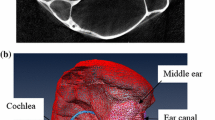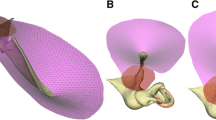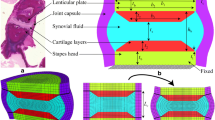Abstract
It is believed that non-mammals have poor hearing at high frequencies because the sound-conduction performance of their single-ossicle middle ears declines above a certain frequency. To better understand this behavior, a dynamic three-dimensional finite-element model of the chicken middle ear was constructed. The effect of changing the flexibility of the cartilaginous extracolumella on middle-ear sound conduction was simulated from 0.125 to 8 kHz, and the influence of the outward-bulging cone shape of the eardrum was studied by altering the depth and orientation of the eardrum cone in the model. It was found that extracolumella flexibility increases the middle-ear pressure gain at low frequencies due to an enhancement of eardrum motion, but it decreases the pressure gain at high frequencies as the bony columella becomes more resistant to extracolumella movement. Similar to the inward-pointing cone shape of the mammalian eardrum, it was shown that the outward-pointing cone shape of the chicken eardrum enhances the middle-ear pressure gain compared to a flat eardrum shape. When the outward-pointing eardrum was replaced by an inward-pointing eardrum, the pressure gain decreased slightly over the entire frequency range. This decrease was assigned to an increase in bending behavior of the extracolumella and a reduction in piston-like columella motion in the model with an inward-pointing eardrum. Possibly, the single-ossicle middle ear of birds favors an outward-pointing eardrum over an inward-pointing one as it preserves a straight angle between the columella and extrastapedius and a right angle between the columella and suprastapedius, which provides the optimal transmission.








Similar content being viewed by others
References
Arechvo I, Zahnert T, Bornitz M, Neudert M, Lasurashvili N, Simkunaite-Rizgeliene R (2013) The ostrich middle ear for developing an ideal ossicular replacement prosthesis. Eur Arch Otorhinolaryngol 270:37–44. https://doi.org/10.1007/s00405-011-1907-1
Bergevin C, Olson ES (2014) External and middle ear sound pressure distribution and acoustic coupling to the tympanic membrane. J Acoust Soc Am 135:1294–1312. https://doi.org/10.1121/1.4864475
De Greef D, Pires F, Dirckx, JJJ (2017) Effects of model definitions and parameter values in finite element modeling of human middle ear mechanics. Hear Res 344:195–206
Fay JP, Puria S, Steele CR (2006) The discordant eardrum. PNAS 103:19743–19748. https://doi.org/10.1073/pnas.0603898104
Filogamo G (1949) Recherches sur la structure de la membrane du tympan chez les differents vertebres. Acta Anat 7:248–272. https://doi.org/10.1159/000140387
Fleischer G (1978) Evolutionary principles of the mammalian middle ear. Adv Anat Embryol Cell Biol 55:1–76. https://doi.org/10.1007/978-3-642-67143-2_1
Funnell WRJ (1983) On the undamped natural frequencies and mode shapes of a finite-element model of the cat eardrum. J Acoust Soc Am 73:1657–1661. https://doi.org/10.1121/1.389386
Funnell WRJ, Laszlo CA (1978) Modeling of the cat eardrum as a thin shell using the finite-element method. J Acoust Soc Am 63:1461–1467. https://doi.org/10.1121/1.381892
Funnell WRJ, Decraemer WF, Khanna SM (1987) On the damped frequency response of a finite-element model of the cat eardrum. J Acoust Soc Am 81:1851–1859. https://doi.org/10.1121/1.394749
Funnell WRJ, Khanna SM, Decraemer WF (1993) On the degree of rigidity of the manubrium in a finite-element model of the cat eardrum. J Acoust Soc Am 91:2082–2090. https://doi.org/10.1121/1.403694
Gan RZ, Feng B, Sun Q (2004) Three-dimensional finite element modeling of the human ear for sound transmission. Ann Biomed Eng 32:847–859. https://doi.org/10.1023/B:ABME.0000030260.22737.53
Gummer AW, Smolders JWT, Klinke R (1989a) Mechanics of a single-ossicle ear: I. The extra-stapedius of the pigeon. Hear Res 39:1–14. https://doi.org/10.1016/0378-5955(89)90077-4
Gummer AW, Smolders JWT, Klinke R (1989b) Mechanics of a single-ossicle ear: II. The columella footplate of the pigeon. Hear Res 39:15–25. https://doi.org/10.1016/0378-5955(89)90078-6
Hemilä S, Nummela S, Reuter T (1995) What middle ear parameters tell about impedance matching and high frequency hearing. Hear Res 85:31–44. https://doi.org/10.1016/0378-5955(95)00031-x
Hill EM, Koay G, Heffner RS, Heffner HE (2014) Audiogram of the chicken (Gallus gallus domesticus) from 2 Hz to 9 kHz. J Comp Physiol A 200:863–870. https://doi.org/10.1007/s00359-014-0929-8
Jiang S, Gan RZ (2018) Dynamic properties of the human incudostapedial joint—experimental measurement and finite element modeling. Med Eng Phys 54:14–21. https://doi.org/10.1016/j.medengphy.2018.02.006
Kinsler LE, Frey AR, Coppens AB, Sanders JV (1999) Fundamentals of acoustics. Wiley, New York
Kirikae J (1960) The structure and function of the middle ear. Dissertation, University of Tokyo
Koike T, Wada H, Kobayashi T (2001) Effect of depth of conical-shaped tympanic membrane on middle-ear sound transmission. JSME Int J Ser C 44:1097–1102. https://doi.org/10.1299/jsmec.44.1097
Kreithen ML, Quine DB (1979) Infrasound detection by the homing pigeon: a behavioral audiogram. J Comp Physiol A 129:1–4. https://doi.org/10.1007/BF00679906
Larsen ON, Christensen-Dalsgaard J, Jensen KK (2016) Role of intracranial cavities in avian directional hearing. Biol Cybern 110:319–331. https://doi.org/10.1007/s00422-016-0688-4
Maftoon N, Funnell WRJ, Daniel SJ, Decraemer WF (2015) Finite-element modelling of the response of the gerbil middle ear to sound. J Assoc Res Otolaryngol 16:547–567. https://doi.org/10.1007/s10162-015-0531-y
Manley GA (1972a) A review of some current concepts of the functional evolution of the ear in terrestrial vertebrates. Evolution 26:608–621. https://doi.org/10.2307/2407057
Manley GA (1972b) Frequency response of the middle ear of geckos. J Comp Physiol 81:251–258. https://doi.org/10.1007/BF00693630
Manley GA (1990) Overview and outlook. In: Manley GA (ed) Peripheral hearing mechanisms in reptiles and birds Zoophysiology. Springer, Berlin, pp 253–273. https://doi.org/10.1007/978-3-642-83615-2_14
Manley GA (2010) An evolutionary perspective on middle ears. Hear Res 263:3–8. https://doi.org/10.1016/j.heares.2009.09.004
Manley GA, Sienknecht UJ (2013) The evolution and development of middle ears in land vertebrates. In: Puria S, Fay RR, Popper AN (eds) The middle ear science, otosurgery, and technology. Springer, New York, NY, pp 7–30. https://doi.org/10.1007/978-1-4614-6591-1_2
Mason MJ, Farr MRB (2013) Flexibility within the middle ears of vertebrates. J Laryngol Otol 127:2–14. https://doi.org/10.1017/S0022215112002496
Mills R, Zhang J (2006) Applied comparative physiology of the avian middle ear: the effect of static pressure changes in columellar ears. J Laryngol Otol 120:1005–1007. https://doi.org/10.1017/S0022215106002581
Motallebzadeh H, Maftoon N, Pitaro J, Funnell WRJ, Daniel SJ (2017) Finite-element modeling of the acoustic input admittance of the newborn ear canal and middle ear. JARO 18:25–48. https://doi.org/10.1007/s10162-016-0587-3
Muyshondt PGG, Aerts P, Dirckx JJJ (2016) Acoustic input impedance of the avian inner ear measured in ostrich (Struthio camelus). Hear Res 339:175–183. https://doi.org/10.1016/j.heares.2016.07.009
Muyshondt PGG, Claes R, Aerts P, Dirckx JJJ (2018) Quasi-static and dynamic motions of the columellar footplate in ostrich (Struthio camelus) measured ex vivo. Hear Res 357:10–24. https://doi.org/10.1016/j.heares.2017.11.005
Muyshondt PGG, Aerts P, Dirckx JJJ (2019) The effect of single-ossicle ear flexibility and eardrum cone orientation on quasi-static behavior of the chicken middle ear. Hear Res 378:13–22. https://doi.org/10.1016/j.heares.2018.10.011
Norberg RÅ (1978) Skull asymmetry, ear structure and function, and auditory localization in Tengmalm’s owl, Aegolius funereus (Linné). Philios Trans R Soc B 282:325–410. https://doi.org/10.1098/rstb.1978.0014
Overstreet EH, Ruggero MA (2002) Development of wide-band middle ear transmission in the Mongolian gerbil. J Acoust Soc Am 111:261–270. https://doi.org/10.1121/1.1420382
Pohlman AG (1921) The position and functional interpretation of the elastic ligaments in the middle-ear of Gallus. J Morphol 35:228–262. https://doi.org/10.1002/jmor.1050350106
Puria S, Steele C (2010) Tympanic-membrane and malleus-incus-complex co-adaptations for high-frequency hearing in mammals. Hear Res 263:183–190. https://doi.org/10.1016/j.heares.2009.10.013
Ravicz ME, Cooper NP, Rosowski JJ (2008) Gerbil middle-ear sound transmission from 100 Hz to 60 kHz. J Acoust Soc Am 124:363–380. https://doi.org/10.1121/1.2932061
Rosowski JJ (2013) Comparative middle ear structure and function in vertebrates. In: Puria S, Fay RR, Popper AN (eds) The middle ear: science, otosurgery, and technology, springer handbook of auditory research. Springer, New York, NY, pp 31–65. https://doi.org/10.1007/978-1-4614-6591-1_3
Rosowski JJ, Peake WT, Lynch TJ, Leong R, Weis TF (1985) A model for signal transmission in an ear having hair cells with free-standing stereocilia. II. Macromechanical stage. Hear Res 20:139–155. https://doi.org/10.1016/0378-5955(85)90165-0
Saunders JC, Duncan RK, Doan DE, Werner YL (2000) The middle ear of reptiles and birds. In: Dooling RJ, Fay RR, Popper AH (eds) Comparative hearing: birds and reptiles. Springer, New York, NY, pp 13–69. https://doi.org/10.1007/978-1-4612-1182-2_2
Smith G (1904) The middle ear and columella of birds. Q J Microsc Sci 48:11–22
Starck JM (1995) Comparative anatomy of the external and middle ear of palaeognathous birds. Adv Anat Embryol Cell Biol 131:1–137. https://doi.org/10.1007/978-3-642-79592-3
Theurich M, Langner G, Scheich H (1984) Infrasound responses in the midbrain of the guinea fowl. Neurosci Lett 49:81–86. https://doi.org/10.1016/0304-3940(84)90140-X
Van der Jeught S, Dirckx JJJ, Aerts JRM, Bradu A, Podoleanu AG, Buytaert JAN (2013) Full-field thickness distribution of human tympanic membrane obtained with optical coherence tomography. J Assoc Res Otolaryngol 14:483–493. https://doi.org/10.1007/s10162-013-0394-z
von Békésy G (1949) The structure of the middle ear and the hearing of one’s own voice by bone conduction. J Acoust Soc Am 21:217–232. https://doi.org/10.1121/1.1906501
Werner YL, Montgomery LG, Safford SD, Igić PG, Saunders JC (1998) How body size affects middle-ear structure and function and auditory sensitivity in gekkonoid lizards. J Exp Biol 201:487–502
Zhang X, Gan RZ (2013) Dynamic properties of human tympanic membrane based on frequency-temperature superposition. Ann Biomed Eng 41:205–214. https://doi.org/10.1007/s10439-012-0624-2
Zhang X, Gan RZ (2014) Dynamic properties of human stapedial annular ligament measured with frequency-temperature superposition. J Biomech Eng 136:0810041–0810047. https://doi.org/10.1115/1.4027668
Acknowledgements
We thank Dr. R. Claes and Dr. J. Goyens for their help with the micro-CT scanning. We acknowledge the funding agency, the Research Foundation—Flanders (FWO), for their financial support, Grant no. 11T9318N.
Author information
Authors and Affiliations
Corresponding author
Ethics declarations
Conflict of interest
The authors declare that they have no conflict of interest.
Additional information
Publisher's Note
Springer Nature remains neutral with regard to jurisdictional claims in published maps and institutional affiliations.
Electronic supplementary material
Below is the link to the electronic supplementary material.
Online Resource 1 Harmonic motion of the columellar apparatus with flexible extracolumella during sound-pressure stimulation of the tympanic membrane at 0.125 kHz (anteromedial view). The motion (colored) is depicted relative to the resting condition (triangulated), but the tympanic membrane, ascending ligament and infrastapedial membrane are hidden. The color scale shows root-mean-square displacements, and the depicted deformation is magnified by a factor of 500 (AVI 793 kb)
Online Resource 2 Harmonic motion of the columellar apparatus with stiff extracolumella during sound-pressure stimulation of the tympanic membrane at 0.125 kHz (anteromedial view). The motion (colored) is depicted relative to the resting condition (triangulated), but the tympanic membrane, ascending ligament and infrastapedial membrane are hidden. The color scale shows root-mean-square displacements, and the depicted deformation is magnified by a factor of 500 (AVI 710 kb)
Online Resource 3 Harmonic motion of the columellar apparatus with flexible extracolumella during sound-pressure stimulation of the tympanic membrane at 1 kHz (anteromedial view). The motion (colored) is depicted relative to the resting condition (triangulated), but the tympanic membrane, ascending ligament infrastapedial membrane are hidden. The color scale shows root-mean-square displacements, and the depicted deformation is magnified by a factor of 1000 (AVI 812 kb)
Online Resource 4 Harmonic motion of the columellar apparatus with stiff extracolumella during sound-pressure stimulation of the tympanic membrane at 1 kHz (anteromedial view). The motion (colored) is depicted relative to the resting condition (triangulated), but the tympanic membrane, ascending ligament and infrastapedial membrane are hidden. The color scale shows root-mean-square displacements, and the depicted deformation is magnified by a factor of 1000 (AVI 711 kb)
Online Resource 5 Harmonic motion of the columellar apparatus with flexible extracolumella during sound-pressure stimulation of the tympanic membrane at 8 kHz (anteromedial view). The harmonic motion (colored) is depicted relative to the resting condition (triangulated), but the tympanic membrane, ascending ligament and infrastapedial membrane are hidden. The color scale shows root-mean-square displacements, and the depicted deformation is magnified by a factor of 30,000 (AVI 916 kb)
Online Resource 6 Harmonic motion of the columellar apparatus with stiff extracolumella during sound-pressure stimulation of the tympanic membrane at 8 kHz (anteromedial view). The motion (colored) is depicted relative to the resting condition (triangulated), but the tympanic membrane, ascending ligament and infrastapedial membrane are hidden. The color scale shows root-mean-square displacements, and the depicted deformation is magnified by a factor of 30,000 (AVI 715 kb)
Rights and permissions
About this article
Cite this article
Muyshondt, P.G.G., Dirckx, J.J.J. How flexibility and eardrum cone shape affect sound conduction in single-ossicle ears: a dynamic model study of the chicken middle ear. Biomech Model Mechanobiol 19, 233–249 (2020). https://doi.org/10.1007/s10237-019-01207-4
Received:
Accepted:
Published:
Issue Date:
DOI: https://doi.org/10.1007/s10237-019-01207-4




